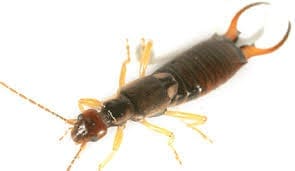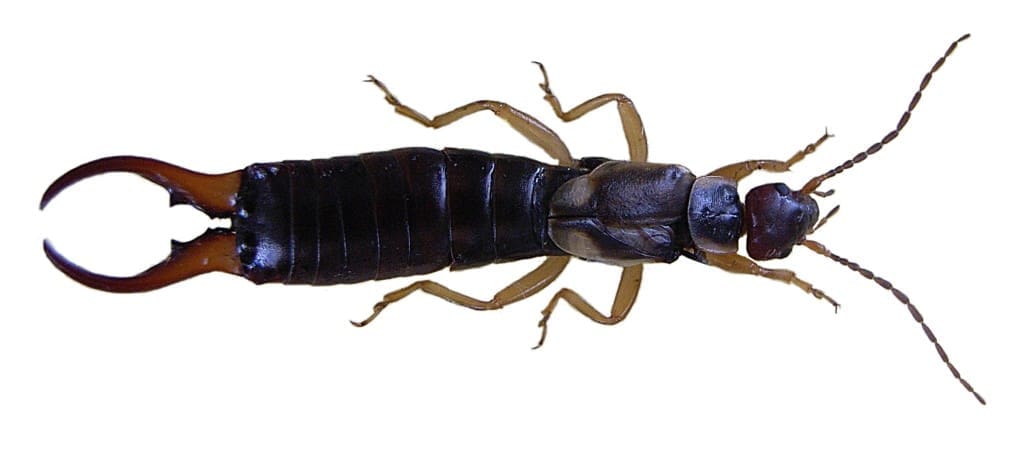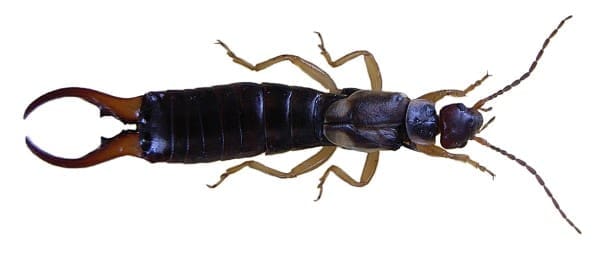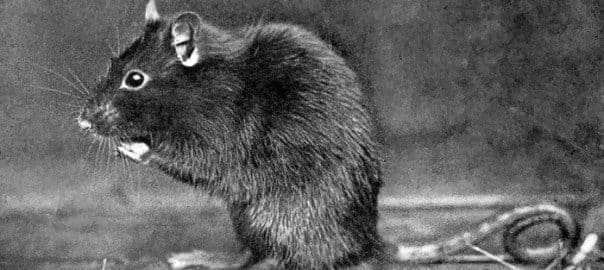Do Earwigs (a.k.a. Pincer Bugs) Really Pinch?
What’s the story of “earwigs”? Do they really get into your ears?
A longstanding rumor is that earwigs burrow into people’s ears to enter the brain, where female earwigs lay eggs. Frightful! If that wasn’t bad enough, the names “Pincer Bug” or “Earwig” accompanied by those prehistoric-looking, gigantic pincers could be pretty alarming.
Are earwigs dangerous? Are they helpful? Are they something we should be concerned about? Let’s examine facts and fiction about our ancient-looking friend, the Earwig.

All About Earwigs
Earwigs are brown bugs with pincers. These pincer bugs seem to pinch with those pair of hook-like “pinchers,” but it doesn’t hurt and this is far from the belief that they get into our ears and brain.
Earwigs tend to hide in dark and damp places during the night. They are nocturnal bugs but can be found anywhere during the day. Most earwigs seek dead wood or plants and musty places like your basement or old wood piles.
Common Myths and Facts About Earwig Pincers
There’s no doubt you have seen pincer bugs before, maybe in your house, the woods, the garden, or basements (I had one crawl out of the endive I purchased at the grocery store once!).
Here are a few myths—and facts—about earwigs that might ease your concerns.
- Myth 1: Earwigs burrow or crawl within the ear canal of sleeping people.
- Myth 2: Their pincers are powerful enough to hurt humans.
- Myth 3: They stay inside the human brain and lay eggs there.
- Myth 4: Their bites are poisonous.
Here’s the truth:
- The very noticeable pincers they sport (called “cerci”) are used primarily for defense but can also be used in mating and to hold prey. Their abdomens are intensely muscular to support the leverage needed to operate the pincers.
- Their pincers can do little or no harm to you. Not a problem.
- They have no interest in crawling into your ear and laying eggs. That’s mostly a myth that started based on their name, which comes from Old English. “Wig” is a modern spelling for a word that primarily means “beetle,” and “ear” likely comes from the fact that their pincers are somewhat like the shape of a human ear.
- Earwigs are a favorite meal of hedgehogs and yellowjacket wasps among others.
- They are nocturnal and love damp woods.
- The common earwigs we typically see have only been in North America for over a hundred years, having arrived here from Europe.
- Earwigs have been around for a very long time. It’s no coincidence that earwigs seem prehistoric; different suborders have existed since the middle Triassic era.
- Earwigs have wings and can fly for short durations but virtually never do so.
- Several suborders of earwigs give live birth. This is rare in the insect world.
- They are scavengers and omnivores and will change their diet to suit their environment.
Ways to Prevent Earwig Infestation
Control and prevent earwig infestation in several ways:
- Eliminate moisture—Earwigs require moisture to survive, so reducing the dampness and humidity in your home is an excellent place to start.
- Seal up gaps and cracks—Earwigs can enter your home through even the tiniest crevices and openings.
- Remove potential food sources—Earwigs feed on decaying plant matter, so removing any piles of leaves, wood, plants, or compost away from your home is essential.
- Trap earwigs—If you know where these pincer bugs enter your home, you can set up traps like sticky traps or barriers.
- Use natural repellents—Some natural repellents that can be used include diatomaceous earth, garlic spray, tea tree oil, spray a diluted solution of citrus oil, or boric acid. This may help, but don’t expect it to be anywhere near 100% effective.
- Call a pest control professional—If you have tried these prevention methods and are still having problems, contact a professional pest control operator to help prevent earwigs.
If earwigs bother you or you have many around your house (especially if you’ve got a yellowjacket problem and the wasps are feeding on earwigs), we have just the service options for you! Our All Pest Plan eliminates earwigs, as well as a variety of other insects with which you might be having trouble.

Give us a call today, and let us handle the dirty work!
5 Star Pest Control Service available in Albany, Ashland, Corvallis, Eugene, Grants Pass, McMinnville, Medford, Newberg, Roseburg, Salem, Sherwood, Wilsonville, Woodburn, Tigard, Tualatin and surrounding areas.



 Town and Country Pest: Your Local Pest Solutions
Town and Country Pest: Your Local Pest Solutions Getting Rid of Mice
Getting Rid of Mice How to Get Rid of Ants
How to Get Rid of Ants Rats in Oregon: Understanding Rodents in the Pacific Northwest
Rats in Oregon: Understanding Rodents in the Pacific Northwest